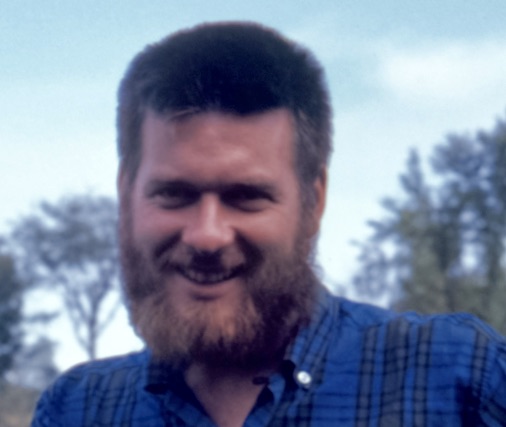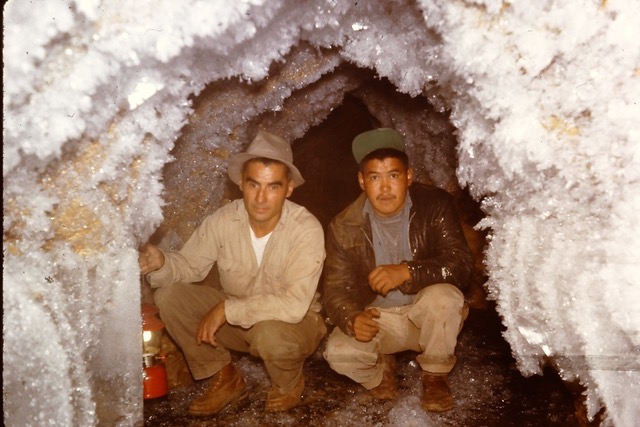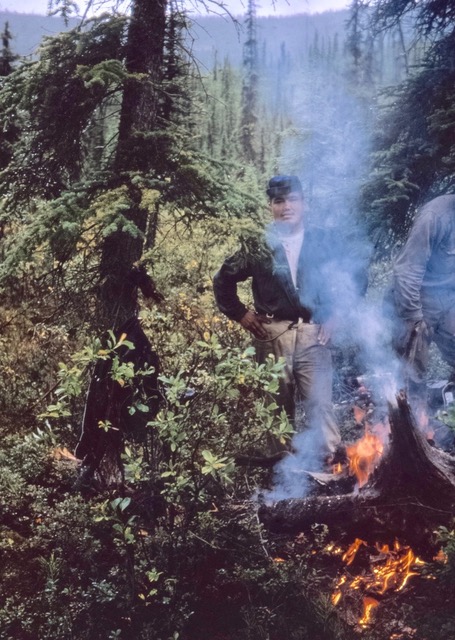EPISODE 383 MEET MOSES LORD…INDIGENOUS PERSON, YUKON TERRITORY, 1962
Our Yukon job in 1961 was my closest relationship with first nations people…mostly
Northern Tuchone from their Mayo Landing Reserve.
This is Moses Lord having canned peaches for lunch on the job. He seemed to
be an important person among his people.
“Do you want to crawl into an old mine?”
“Sure do.”
“Then come along with Dinky and me…I”ll bring a lantern.”
(Strange, I do not remember Moses ever calling me Alan…)
alan skeoch
July 2021
MEET MOSES LORD
My two previous indigenous person stories were based on short
meetings. Very short…maybe 5 minutes max. Enough time to make
a lasting impression on me but really not enough time to make into a big
deal. Hell, the first contact was not even with a real indigenous person. In that
incident I was mistaken for a First Nations person. “Look, there’s an Indian up
on that rock outcrop. Take a picture, quick.” It was m sitting on the outcrop…skins
bed brown by exposure.
The second incident lacked humour. An incident of which I am not proud…even
at the time in May, 1960, I was uneasy with what I had done. I took pictures
that would have been best not taken. Unflatteirng pictures.
Now is the time for my third experience with First Nations people. Much much longer.
Moses Lord and I worked together from May to September, off and on. He was one
of our employees. Not hired because he was indigenous. Just hired from the available
labour pool in Mayo Landing, Yukon Territory.
The only way I knew he was aboriginal was because of his name. Moses Lord had
the clear ring of an imposed name given by some kind of Christian missionary .
Moses was old enough to be my father…I was 22 and he seemed somewhere between
50 and 60.
Now I wonder if he had been one of the native children yanked from their
parens aNd put in a kind of prison known as a ‘residential school’. That thought
never crossed my mind in 1962. I did not even know much about residential schools.
The subject never came up during the whole summer.
Moses was a nice man to work with. Friendly. Once he knew I was interested in
finding abandoned placer gold mines dating back to the end of the 19th century
he showed me one that we could explore. Most placer gold mines were vertical..i.e.
miners dug down through the permafrost to bed rock where gold nuggets and
gold dust was possibly trapped in the cracks or faults in the rock. A few were
horizontal where miners had tunnelled into hillsides. The one that Moses
showed me was fantastic as the tunnel was festooned with ice crystals and seemed
a fairyland. At one point we even found well worn shovels and pickaxes.
So I considered myself close to Moses. When I began writing this episode I expected
to say how a warm relationship was established. That would be an overstatement.
Granted we got along well although
it must have been hard for Moses who was perhaps 50 years of age having to do what
a 22 year old ‘boss’ decided was necessary.
In retrospect I realize we were not close. Friends…yes. But I had no idea whether Moses was Northern Tuchone
like most local First Nations were. Most but not all. I knew nothing of his family except he lived in a house
on the reserve ‘that seems filled with women of all ages’. He was married…had children…perhaps
grandchildren but I never asked about them. In other words there was social distance between
us. This was not intentional. Perhaps due to respect… for I noticed other First Nation workers seemed to
defer to Moses. “Dinky” for instance who is in the mine tunnel with Moses. Dinky had a trap line…Moses related how
a wolverine crawled down the stove pipe of Dinky’s cabin…vicious, solitary creatures. Dinky never said a word.
When the job was over and I was packing up our equipment in September one of the local
people…I think it was Moses…said:
“How would you like a set of caribou antlers?”
“Love to pay for a set.”
“No pay. There is a set leaning against our house…you can have them.”
And I still have them.
Caribou antlers. I never saw a wild caribou in all my years doing mining exploration.
piled on to get smoke … our defence against the flies.
about something related to the Yukon and I mentioned Moses. When
the broadcast was over i was called to the broadcast booth. “Call for
say thank you for mentioning her dad. Maybe we were closer than I thought.
The First Nation of Na-Cho Nyäk Dun represents the most northerly community of the Northern Tutchone language and culture group. In the Northern Tutchone language the Stewart River is called Na Cho Nyak, meaning Big River.
Historically, the First Nation of Na-Cho Nyäk Dun lived and trapped throughout the area, using the rich supply of game animals, fish, birds, and numerous plants for food and for medicinal purposes.
Their lifestyle required traveling throughout the First Nation’s traditional territory at various times of the year, for hunting, fishing, and gathering food to survive.
Today, the Na-Cho Nyäk Dun has a membership of 602. As a self-governing First Nation, the First Nation has the ability to develop and adopt laws on behalf of their citizens and their Settlement lands.
They are actively involved in affairs of the Mayo community to promote a better, healthier lifestyle for its future generations and a strong economy based on its rich natural resources.





